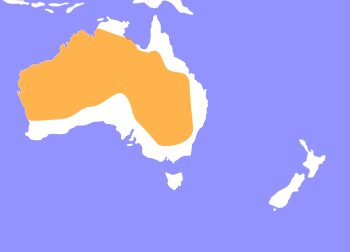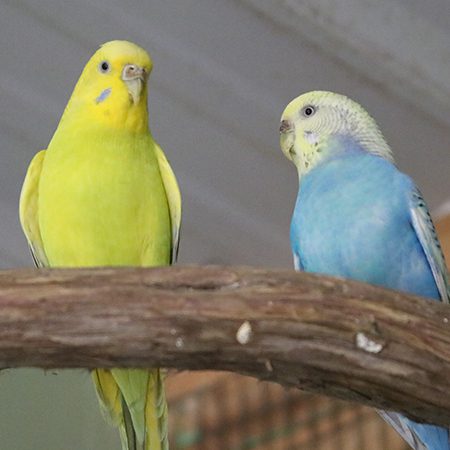Budgerigar
Melopsittacus undulatus
The budgerigar is a long-tailed, seed-eating parrot usually nicknamed the budgie parakeet. Budgies are the only species in the genus Melopsittacus. The species is green and yellow with black, scalloped markings on the nape, back, and wings. Budgies are bred in captivity with colouring of blues, whites, yellows, greys, and even with small crests.
The origin of the budgie's name is unclear. First recorded in 1805, budgerigars are popular pets around the world due to their small size, low cost, and ability to mimic human speech. They are the third most popular pet in the world, after the domesticated dog and cat. Budgies are nomadic flock parakeets that have been bred in captivity since the 19th century. In both captivity and the wild, budgerigars breed opportunistically and in pairs. Found wild throughout the drier parts of Australia, prior to colonisation they had survived harsh inland conditions for five million years. The budgerigar is closely related to lories and the fig parrots.
Wild budgerigars average 18 cm (7 in) long, weigh 30–40 grams (1.1–1.4 oz), 30 cm (12 in) in wingspan. Budgerigars are nomadic and flocks move on from sites as environmental conditions change. Budgerigars are found in open habitats, primarily in scrublands, open woodlands, and grasslands of Australia. The birds are normally found in small flocks, but can form very large flocks under favourable conditions. The nomadic movement of the flocks is tied to the availability of food and water. Drought can drive flocks into more wooded habitat or coastal areas. They feed on the seeds of spinifex, grass seeds, and sometimes ripening wheat.

Budgerigar Parakeets are found throughout the drylands of Australia.
HABITAT -Scrublands, open woodlands, and grasslands of Australia.
DIET -They feed on the seeds of spinifex, grass seeds, and sometimes ripening wheat.
FUN FACT -A budgie can have up to 3,000 feathers in total across their whole body!
SOCIAL BEHAVIOR -They are social birds and don’t do well in isolation. Budgies form flocks and are house pets.
ACTIVITY -They are diurnal being most active during the day and resting during the evening.
PREDATORS -Predators include snakes and birds of prey such as hawks.
SIZE -Wild budgerigars average 18 cm (7 in) long, weigh 30–40 grams (1.1–1.4 oz), 30 cm (12 in) in wingspan.
RELATIVES -The closest relative of the budgie are lories and lorikeets.
CONSERVATION -Blue Fronted Amazons are categorized as NT (Near Threatened) species by the IUCN.
Cub Creek Animal Care Information
Housing - We house our birds in one of our indoor flight enclosures.. Our enclosures are large rooms filled with trees! They are the newest renovation to the jungle building! Housing our birds in flight enclosures rather than small cages allows for more socialization and room to let their wings stretch! They have many branches all over the enclosure to perch on and fly to and fro. There is also a window where they can observe what is going on outside. Our budgies live with cockatiels and a dove as well as chinchillas.
Diet - These birds are fed ZuPreem small bird pellets, which includes everything they need to be healthy and receive all the necessary nutrients. They are also given bird salad, a mix of diced apples, shredded sweet potato, and chopped lettuce. Fresh water is given daily.
Enrichment - Their multi-species enclosure (with chinchillas and other bird species) provides enrichment through daily interactions and get to play with toys that are made for the others. Campers can use cardboard, twine, and pretty much anything we can find to make hanging toys that can have food hidden in them or just used to swing on!

